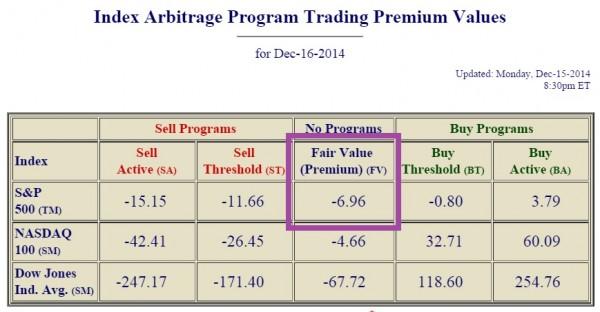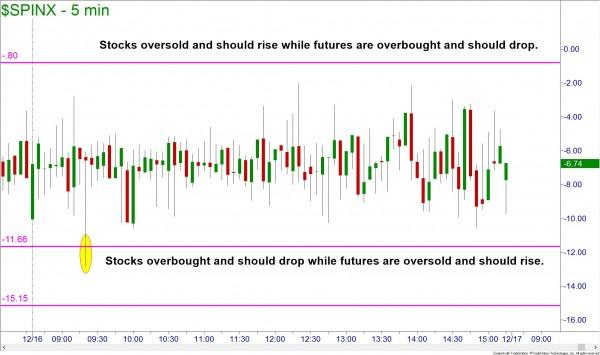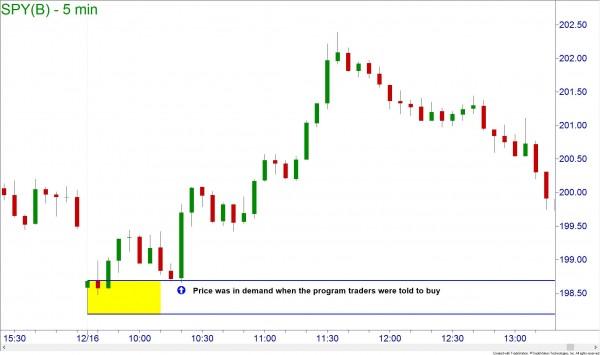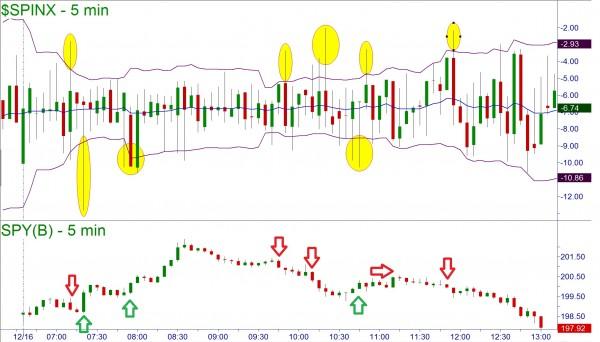While teaching a Professional Futures Trader course in Kansas City last week, I was demonstrating a technique that can predict the morning reversal of the S&P 500 Index and the related futures contracts due to arbitrage opportunities. This is a technique that I have used successfully for years when I traded stocks. It can also be used as an odds enhancer for intraday trading under certain circumstances.
This week I will discuss the overall use of the tool for increasing your chances for successful trading. In next week’s follow up article, I will detail the trading technique I use in order to take advantage of this arbitrage.
For those who may not know, there are a group of institutional traders, called program traders, who have their computers set to recognize mispricing between the S&P 500 Index and the S&P 500 Futures. When the mispricing occurs, they buy the undervalued security (or the stocks making up the index) and sell the overvalued one. This is known as an arbitrage opportunity.
Futures trade with high leverage in comparison to the stocks making up the indexes. Buying 100 shares of the SPY (the ETF that tracks the S&P 500 index) would cost nearly $19,700 at the time of this writing. Even with 2:1 margin, a trader would need $9850 to maintain the position. To trade one contract of the ES, (the S&P 500 eMini future), a trader only needs $5060. Or much less if it is an intraday trade.
Since a trader can put down smaller margin and trade futures in lieu of stocks, they could earn interest on the money they are not using by buying stock. Well, maybe when the US banks actually pay interest again. So the futures exchanges attach a fair value to the futures in order to make them priced similarly to the equivalent index. Additionally, a futures trader will not receive dividends as would the stock or ETF trader. That dividend value is subtracted from the interest to arrive at the fair value.
Futures Fair Value = Interest available on the future contract until expiration minus the dividends to be paid on the stocks until the expiration.
The fair value only changes once a day when the equity market closes. That is when a stock would go ex-div and pay out a dividend and also when there is one less day of interest until expiration. There are plenty of sites that show you the fair value number. I tend to check www.indexarb.com to get the data.
As you can see from the fair value, the S&P Futures should be trading 6.96 points below the S&P 500 Index for the entire day. The buy and sell thresholds tell the program traders when the two are mispriced and ready for an arbitrage opportunity. Should the difference between the two become less than 0.80, some of the program traders will buy the undervalued stocks in the S&P 500 and sell the S&P futures to bring the two back in line. If a larger move on the futures pushes the price above what the index is trading at by more than 3.79, then all of the programs traders should act and a sharp movement in the markets would result.
The opposite would occur should the difference between the S&P index and the futures become too great. If the price gap between the two grows greater than 11.66, then some program traders will buy the futures and sell most of the stocks making up the S&P 500 index. If the price of the futures drops more than 15.15 below the price of the index, then all of the program traders should move in and buy futures and short the stocks. This will result in a larger move in both the index and the futures.
In Trade Station, you can chart the difference between the S&P 500 index and the S&P 500 futures. This is called the premium and the symbol is $SPINX. If we look at the following chart of the premium along with the program trading buy and sell thresholds drawn on the chart, we can identify the times when these programs will move the markets.
You can see that early in the morning about an hour after the equity markets open, the premium was too low. This caused a rally in the equity markets until the premium was near the -6.96 target. This gave a knowledgeable trader an excellent trading opportunity since price was also at demand. Note that the $SPINX chart is on central time while the SPY chart is eastern.
On any given day, when you are watching your stock approaching a supply zone and are trying to decide whether you should sell or short the level, look at what the premium is doing. If it is approaching the lower levels or sell thresholds, then you should have more confidence that the level will hold. If you are looking at a demand zone on your stock and the premium is moving up to or beyond the buy threshold, you should have a higher confidence of the demand zone working.
I decided to take it one step further and placed a Bollinger Band set to 20 periods and an exponential moving average on the premium chart. I noticed that when the band was pierced, it often corresponded with an immediate change of trend direction in the SPY ETF.
We must not forget that we need to center our trading decisions on supply, demand, and trend. So while the premium chart with Bollinger Bands is not the holy grail of technical analysis, it is something that a trader can use as a decision support tool.
Neither Freedom Management Partners nor any of its personnel are registered broker-dealers or investment advisers. I will mention that I consider certain securities or positions to be good candidates for the types of strategies we are discussing or illustrating. Because I consider the securities or positions appropriate to the discussion or for illustration purposes does not mean that I am telling you to trade the strategies or securities. Keep in mind that we are not providing you with recommendations or personalized advice about your trading activities. The information we are providing is not tailored to any individual. Any mention of a particular security is not a recommendation to buy, sell, or hold that or any other security or a suggestion that it is suitable for any specific person. Keep in mind that all trading involves a risk of loss, and this will always be the situation, regardless of whether we are discussing strategies that are intended to limit risk. Also, Freedom Management Partners’ personnel are not subject to trading restrictions. I and others at Freedom Management Partners could have a position in a security or initiate a position in a security at any time.
Editors’ Picks

EUR/USD Price Annual Forecast: Growth to displace central banks from the limelight in 2026 Premium
What a year! Donald Trump’s return to the United States (US) Presidency was no doubt what led financial markets throughout 2025. His not-always-unexpected or surprising decisions shaped investors’ sentiment, or better said, unprecedented uncertainty.

Gold Price Annual Forecast: 2026 could see new record-highs but a 2025-like rally is unlikely Premium
Gold hit multiple new record highs throughout 2025. Trade-war fears, geopolitical instability and monetary easing in major economies were the main drivers behind Gold’s rally.

GBP/USD Price Annual Forecast: Will 2026 be another bullish year for Pound Sterling? Premium
Having wrapped up 2025 on a positive note, the Pound Sterling (GBP) eyes another meaningful and upbeat year against the US Dollar (USD) at the start of 2026.

US Dollar Price Annual Forecast: 2026 set to be a year of transition, not capitulation Premium
The US Dollar (USD) enters the new year at a crossroads. After several years of sustained strength driven by US growth outperformance, aggressive Federal Reserve (Fed) tightening, and recurrent episodes of global risk aversion, the conditions that underpinned broad-based USD appreciation are beginning to erode, but not collapse.

Bitcoin Price Annual Forecast: BTC holds long-term bullish structure heading into 2026
Bitcoin (BTC) is wrapping up 2025 as one of its most eventful years, defined by unprecedented institutional participation, major regulatory developments, and extreme price volatility.
RECOMMENDED LESSONS
Making money in forex is easy if you know how the bankers trade!
I’m often mystified in my educational forex articles why so many traders struggle to make consistent money out of forex trading. The answer has more to do with what they don’t know than what they do know. After working in investment banks for 20 years many of which were as a Chief trader its second knowledge how to extract cash out of the market.
5 Forex News Events You Need To Know
In the fast moving world of currency markets where huge moves can seemingly come from nowhere, it is extremely important for new traders to learn about the various economic indicators and forex news events and releases that shape the markets. Indeed, quickly getting a handle on which data to look out for, what it means, and how to trade it can see new traders quickly become far more profitable and sets up the road to long term success.
Top 10 Chart Patterns Every Trader Should Know
Chart patterns are one of the most effective trading tools for a trader. They are pure price-action, and form on the basis of underlying buying and selling pressure. Chart patterns have a proven track-record, and traders use them to identify continuation or reversal signals, to open positions and identify price targets.
7 Ways to Avoid Forex Scams
The forex industry is recently seeing more and more scams. Here are 7 ways to avoid losing your money in such scams: Forex scams are becoming frequent. Michael Greenberg reports on luxurious expenses, including a submarine bought from the money taken from forex traders. Here’s another report of a forex fraud. So, how can we avoid falling in such forex scams?
What Are the 10 Fatal Mistakes Traders Make
Trading is exciting. Trading is hard. Trading is extremely hard. Some say that it takes more than 10,000 hours to master. Others believe that trading is the way to quick riches. They might be both wrong. What is important to know that no matter how experienced you are, mistakes will be part of the trading process.
The challenge: Timing the market and trader psychology
Successful trading often comes down to timing – entering and exiting trades at the right moments. Yet timing the market is notoriously difficult, largely because human psychology can derail even the best plans. Two powerful emotions in particular – fear and greed – tend to drive trading decisions off course.






